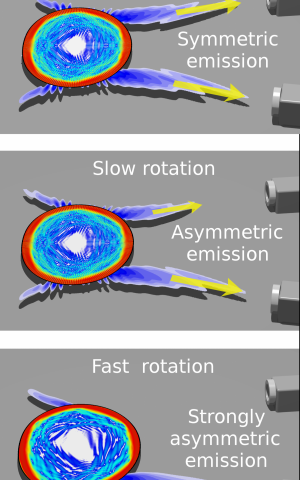World's Smallest Light-Powered Gyroscope is Now More Sensitive
| Marco Foronda | | Apr 03, 2015 07:48 AM EDT |
(Photo : Li Ge, physicist at the Graduate Center and Staten Island College, City University of New York) Schematics showing the far-field emission pattern of a microdisk cavity changing from symmetric to strongly asymmetric. Two cameras on the right monitor the change.
A pair of light waves-one zipping clockwise, the other counter-clockwise around a microscopic track-may hold the key to creating the world's smallest gyroscope a fraction of the width of a human hair.
By bringing this essential technology down to an entirely new scale, a team of applied physicists hopes to enable a new generation of phenomenally compact gyroscope-based navigation systems, among other intriguing applications.
Like Us on Facebook
"We have found a new detection scheme that may lead to the world's smallest gyroscope. Though these so-called optical gyroscopes are not new, our approach is remarkable both in its super-small size and potential sensitivity," said Li Ge, a physicist at the Graduate Center and Staten Island College, City University of New York.
More than creative learning toys, gyroscopes are indispensable components in a number of technologies, including inertial guidance systems, which monitor an object's motion and orientation. Space probes, satellites, and rockets continuously rely on these systems for accurate flight control. But like so many other essential pieces of aerospace technology, weight is a perennial problem.
NASA says it costs about $10,000 for every pound lifted into orbit, so designing essential components that are smaller and lighter is a constant struggle for engineers and project managers.
To start the new optical gyroscope, light waves are first pumped into an optical cavity. This naturally produces light waves traveling in both clockwise and counterclockwise directions. This behavior is similar to plucking a guitar string in the middle, sending vibrations in both directions simultaneously.
Though this only reveals one plane of motion, multiple sensors at different orientations will be able to give a fully three-dimensional picture of how the object is moving.
Researchers have called for further studies to look at the possibility that many modes, or light paths, exist simultaneously in the cavity. There are many ways in which their far-field emission patterns may change to cause a reduction of the sensitivity to rotation.
Work is on to devise different methods to gain control over this effect.
TagsWorld's Smallest Light-Powered Gyroscope is Now More Sensitive, Light-Powered Gyroscope, Gyroscope, Light Waves, optical gyroscope
©2015 Chinatopix All rights reserved. Do not reproduce without permission
EDITOR'S PICKS
-

Did the Trump administration just announce plans for a trade war with ‘hostile’ China and Russia?
-

US Senate passes Taiwan travel bill slammed by China
-

As Yan Sihong’s family grieves, here are other Chinese students who went missing abroad. Some have never been found
-

Beijing blasts Western critics who ‘smear China’ with the term sharp power
-

China Envoy Seeks to Defuse Tensions With U.S. as a Trade War Brews
-

Singapore's Deputy PM Provides Bitcoin Vote of Confidence Amid China's Blanket Bans
-

China warns investors over risks in overseas virtual currency trading
-

Chinese government most trustworthy: survey
-

Kashima Antlers On Course For Back-To-Back Titles
MOST POPULAR
LATEST NEWS
Zhou Yongkang: China's Former Security Chief Sentenced to Life in Prison

China's former Chief of the Ministry of Public Security, Zhou Yongkang, has been given a life sentence after he was found guilty of abusing his office, bribery and deliberately ... Full Article
TRENDING STORY

China Pork Prices Expected to Stabilize As The Supplies Recover

Elephone P9000 Smartphone is now on Sale on Amazon India

There's a Big Chance Cliffhangers Won't Still Be Resolved When Grey's Anatomy Season 13 Returns

Supreme Court Ruled on Samsung vs Apple Dispute for Patent Infringement

Microsoft Surface Pro 5 Rumors and Release Date: What is the Latest?










